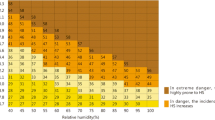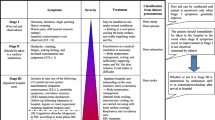Abstract
The prognosis of heat stroke in patients is directly related to the degree of hyperthermia and its duration. Therefore, the most important feature in the treatment of heat stroke is rapid cooling. Several cooling methods have been presented in the literature including immersion in water at different temperatures, evaporative cooling, ice pack application, pharmacological treatment and invasive techniques. This article describes the various cooling techniques in terms of efficacy, availability, adverse effects and mortality rate. Data suggest that cooling should be initiated immediately at time of collapse and should be based on feasible field measures including ice or tepid water (1–16°C), which are readily available. In the emergency department, management should be matched to the patient’s age and medical background and include immersion in ice water (1–5°C) or evaporative cooling.





Similar content being viewed by others
References
Bouchama A, Knochel JP. Heat stroke. N Engl J Med, 2002; 346(25): 1978–88
Epstein Y, Sohar E, Shapiro Y. Exertional heat stroke: a preventable condition. Isr J Med Sci 1995; 31: 454–62
Shibolet S, Coll R, Gilat T, et al. Heatstroke: its clinical picture and mechanism in 36 cases. Q J Med 1967; 36: 525–47
Hall DM, Buettner GR, Oberley LW, et al. Mechanisms of circulatory and intestinal barrier dysfunction during whole body hyperthermia. Am J Physiol Heart Circ Physiol 2001; 280(2): H509–21
Bouchama A, Bridey F, Hammami MM, et al. Activation of coagulation and fibrinolysis in heatstroke. Thromb Haemost 1996; 76(6): 909–15
Chang DM. The role of cytokines in heat stroke. Immunol Invest 1993; 22(8): 553–61
Shapiro Y, Rosenthal T, Sohar E. Experimental heat-stroke: a model in dogs. Arch Intern Med 1973; 131: 688–91
Shapiro Y, Seidman DS. Field and clinical observations of exertional heat stroke patients. Med Sci Sports Exerc 1990; 22: 6–14
Buckley IK. A light and electron microscopic study of thermally injured cultured cells. Lab Invest 1972; 26(2): 201–9
Sakaguchi Y, Stephens LC, Makino M, et al. Apoptosis in tumors and normal tissues induced by whole body hyperthermia in rats. Cancer Res 1995; 55(22): 5459–64
Bynum GD, Pandolf KB, Schuette WH, et al. Induced hyperthermia in sedated humans and the concept of critical thermal maximum. Am J Physiol 1978; 235(5): R228–36
Harker J, Gibson P. Heat-stroke: a review of rapid cooling techniques. Intensive Crit Care Nurs 1995; 11(4): 198–202
Sandor RP. Heat illness: on-site diagnosis and cooling. Phys Sportsmed 1997; 25: 35–40
Graham BS, Lichtenstein MJ, Hinson JM, et al. Nonexertional heatstroke: physiologic management and cooling in 14 patients. Arch Intern Med 1986; 146(1): 87–90
Wyndham CH, Strydom NB, Cooke HM. Methods of cooling subjects with hyperpyrexia. J Appl Physiol 1959; 14: 771–6
Weiner JS, Khogali M. A physiological body-cooling unit for treatment of heat stroke. Lancet 1980; I: 507–9
Rowell LB. Human cardiovascular adjustments to exercise and thermal stress. Physiol Rev 1974; 54(1): 75–159
Proppe DW, Brengelmann GL, Rowell LB. Control of baboon limb blood flow and heart rate-role of skin vs core temperature. Am J Physiol 1976; 231 (5 Pt 1): 1457–65
Rowell LB. Cardiovascular aspects of human thermoregulation. Circ Res 1983; 52(4): 367–79
Armstrong LE, Crago AE, Adams R, et al. Whole-body cooling of hyperthermic runners: comparison of two field therapies. Am J Emerg Med 1996; 14: 355–8
Costrini A. Emergency treatment of exertional heatstroke and comparison of whole body cooling techniques. Med Sci Sports Exerc 1990; 22(1): 15–8
Daily WM, Harrison TR. A study of the mechanism and treatment of experimental heat pyrexia. Am J Med Sci 1948; 215: 42–55
Ferris EB, Blankenhorn MA, Robinson HW, et al. Heat stroke: clinical and chemical observations in 44 cases. J Clin Invest 1938; 17: 249–62
O’Donnell TF. Medical problems of recruit training: a research approach. US Navy Med 1971; 58: 28–31
Magazanik A, Epstein Y, Udassin R, et al. Tap water, an efficient method for cooling heatstroke victims: a model in dogs. Aviat Space Environ Med 1980; 51(9): 864–6
Proulx CI, Ducharme MB, Kenny GP. Effect of water temperature on cooling efficiency during hyperthermia in humans. J Appl Physiol 2003; 94(4): 1317–23
Clements JM, Casa DJ, Knight J, et al. Ice-water immersion and cold-water immersion provide similar cooling rates in runners with exercise-induced hyperthermia. J Athl Train 2002; 37(2): 146–50
McArdle WD, Magel JR, Lesmes GR, et al. Metabolic and cardiovascular adjustment to work in air and water at 18, 25, and 33 degrees C. J Appl Physiol 1976; 40(1): 85–90
Barcroft H, Edholm OG. The effect of temperature on blood flow and deep temperature in the human forearm. J Physiol 1943; 102: 5–20
Eichler AC, McFee AS, Root HD. Heat stroke. Am J Surg 1969; 118(6): 855–63
Jacobson S. The ill effects of heat. Emerg Med 1992; 24(7): 313–24
Francis KT. Exertional heat illness: a review. J Med Technol 1984; 1(7): 547–51
O’Donnell Jr TF, Clowes Jr GH. The circulatory abnormalities of heat stroke. N Engl J Med 1972; 287(15): 734–7
Travis SP. Management of heat stroke. J R Nav Med Serv 1988; 74(1): 39–43
Khogali M. The Makkah body cooling unit. In: Khogali M, Hales JRS, editors. Heatstroke and temperature regulation. Sydney: Academic Press, 1983: 139–48
Khogali M, Weiner JS. Heat stroke: report on 18 cases. Lancet 1980; II(8189): 276–8
Khogali M, Al-Khawashki MI. Heatstroke during the Makkah pilgrimmage. Saudi Med J 1981; 2: 85–93
Al-Aska AK, Abu-Aisha H, Yaqub B, et al. Simplified cooling bed for heatstroke [letter]. Lancet 1987; I(8529): 381
Poulton TJ, Walker RA. Helicopter cooling of heatstroke victims. Aviat Space Environ Med 1987; 58(4): 358–61
Hadad E, Moran DS, Epstein Y. Cooling heat stroke patients by available field measures. Intensive Care Med 2004 Feb; 30(2): 338. Epub 2003 Nov 29
Noakes TD. Heatstroke during the 1981 National Cross-Country Running Championships [letter]. S Afr Med J 1982; 61(5): 145
Richards R, Richards D, Schofield PJ, et al. Management of heat exhaustion in Sydney’s the Sun City-to-Surf fun runners. Med J Aust 1979; 2(9): 457–61
Richards R, Richards D. Exertion-induced heat exhaustion and other medical aspects of the City-to-Surf fun runs 1978–1984. Med J Aust 1984 Dec 8–22; 141(12–13): 799–805
Kielblock AJ, Van Rensburg JP, Franz RM. Body cooling as a method for reducing hyperthermia: an evaluation of techniques. S Afr Med J 1986 Mar 15; 69(6): 378–80
Bynum G, Patton J, Bowers W, et al. Peritoneal lavage cooling in an anesthetized dog heatstroke model. Aviat Space Environ Med 1978; 49(6): 779–84
Horowitz BZ. The golden hour in heat stroke: use of iced peritoneal lavage. Am J Emerg Med 1989; 7(6): 616–9
White JD, Kamath R, Nucci R, et al. Evaporation versus iced peritoneal lavage treatment of heatstroke: comparative efficacy in a canine model. Am J Emerg Med 1993; 11(1): 1–3
Syverud SA, Barker WJ, Amsterdam JT, et al. Iced gastric lavage for treatment of heatstroke: efficacy in a canine model. Ann Emerg Med 1985; 14(5): 424–32
White JD, Riccobene E, Nucci R, et al. Evaporation versus iced gastric lavage treatment of heatstroke: comparative efficacy in a canine model. Crit Care Med 1987; 15(8): 748–50
Mack WJ, Huang J, Winfree C, et al. Ultrarapid, convection-enhanced intravascular hypothermia: a feasibility study in nonhuman primate stroke. Stroke 2003; 34(8): 1994–9
Schmutzhard E, Engelhardt K, Beer R, et al. Safety and efficacy of a novel intravascular cooling device to control body temperature in neurologic intensive care patients: a prospective pilot study. Crit Care Med 2002; 30(11): 2481–8
Inderbitzen B, Yon S, Lasheras J, et al. Safety and performance of a novel intravascular catheter for induction and reversal of hypothermia in a porcine model. Neurosurgery 2002; 50(2): 364–70
Ward A, Chaffman MO, Sorkin EM. Dantrolene: a review of its pharmacodynamic and pharmacokinetic properties and therapeutic use in malignant hyperthermia, the neuroleptic malignant syndrome and an update of its use in muscle spasticity. Drugs 1986; 32(2): 130–68
Lydiatt JS, Hill GE. Treatment of heat stroke with dantrolene [letter]. JAMA 1981; 246(1): 41–2
Denborough M. Severe heat stroke in an experienced athlete [letter]. Med J Aust 1982; 1: 204
Amsterdam JT, Syverud SA, Barker WJ, et al. Dantrolene sodium for treatment of heat stroke victims: lack of efficacy in a canine model. Am J Emerg Med 1986; 4: 399–405
Channa AB, Seraj MA, Saddique AA, et al. Is dantrolene effective in heat stroke patients? Crit Care Med 1990; 18(3): 290–2
Bouchama A, Cafege A, Devol EB, et al. Ineffectiveness of dantrolene sodium in the treatment of heatstroke. Crit Care Med 1991; 19(2): 176–80
Moran D, Epstein Y, Wiener M, et al. Dantrolene and recovery from heat stroke. Aviat Space Environ Med 1999; 70(10): 987–9
Zuckerman GB, Singer LP, Rubin DH, et al. Effects of dantrolene on cooling times and cardiovascular parameters in an immature porcine model of heatstroke. Crit Care Med 1997; 25(1): 135–9
Bouchama A, Parhar RS, el-Yazigi A, et al. Endotoxemia and release of tumor necrosis factor and interleukin 1 alpha in acute heatstroke. J Appl Physiol 1991; 70(6): 2640–4
Bouchama A, al-Sedairy S, Siddiqui S, et al. Elevated pyrogenic cytokines in heatstroke. Chest 1993; 22: 553–61
Hammami MM, Bouchama A, Al-Sedairy S, et al. Concentrations of soluble tumor necrosis factor and interleukin-6 receptors in heatstroke and heat stress. Crit Care Med 1997; 25(8): 1314–9
Feldberg W, Gupta KP, Milton AS, et al. Effect of pyrogens and antipyretics on prostaglandin activity in cisternal c.s.f of unanaesthetized cats. J Physiol 1973; 234: 279–303
Yarbrough BA, Hubbard RW. Heat related illness. In: Auerbach PS, Gelhr EC, editors. Management of wilderness and environmental emergencies. St Louis (MO): Mosby, 1989: 119–43
Henker R, Rogers S, Kramer DJ, et al. Comparison of fever treatments in the critically ill: a pilot study. Am J Crit Care 2001; 10(4): 276–80
Moran DS, Gaffin SL. Clinical management of heat-related illnesses. In: Aurbach PS, editor. Wilderness medicine. St Louis (MO): Mosby, 2001: 290–316
Armstrong LE, Epstein Y, Greenleaf JE, et al. American College of Sports Medicine position stand: heat and cold illnesses during distance running. Med Sci Sports Exerc 1996; 28(12): i–x
Binkley HM, Beckett J, Casa DJ, et al. National Athletic Trainers’ Association position statement: exertional heat illnesses. J Athl Train 2002; 37(3): 329–43
Khogali M, El-Sayed H, Amar M, et al. Management and therapy regimen during cooling and in the recovery room at different heatstroke treatment centers. In: Khogali M, Hales JRS, editors. Heatstroke and temperature regulation. New York: Academic Press, 1983: 149–56
Tucker LE, Stanford J, Graves B, et al. Classical heatstroke: clinical and laboratory assessment. South Med J 1985; 78(1): 20–5
Tipton MJ, Allsopp AJ, Balmi PJ, et al. Hand immersion as a method of cooling and rewarming. J R Nav Med Serv 1993; 79: 125–31
Neill WA, Duncan DA, Kloster F, et al. Response of coronary circulation to cutaneous cold. Am J Med 1974; 56: 471–6
Roberts WO. Managing heatstroke: on site cooling. Phys Sportsmed 1992; 20(5): 17–9
Management of heatstroke. Lancet 1982; II(8304): 910–1
Clapp AJ, Bishop PA, Muir I, et al. Rapid cooling techniques in joggers experiencing heat strain. J Sci Med Sport 2001; 4(2): 160–7
Mitchell JB, Schiller ER, Miller JR, et al. The influence of different external cooling methods on thermoregulatory responses before and after intense intermittent exercise in the heat. J Strength Cond Res 2001; 15(2): 247–54
Acknowledgements
No sources of funding were used to assist in the preparation of this review. The authors have no conflicts of interest that are directly relevant to the content of this review.
Author information
Authors and Affiliations
Corresponding author
Rights and permissions
About this article
Cite this article
Hadad, E., Rav-Acha, M., Heled, Y. et al. Heat Stroke. Sports Med 34, 501–511 (2004). https://doi.org/10.2165/00007256-200434080-00002
Published:
Issue Date:
DOI: https://doi.org/10.2165/00007256-200434080-00002




